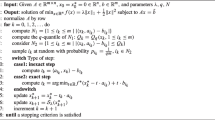Abstract
This paper presents rank-awareness algorithms to solve sparse blind deconvolution using modulated input. We consider sparse blind deconvolution as a rank-one column-sparse matrix recovery problem, so the proposed algorithms can use both the rank-one property and the sparsity of the unknowns. Unknown input \(\varvec{s}\) is first multiplied by a random sign sequence \(\varvec{r}\) and then convolved with an arbitrary filter \(\varvec{h}\) to obtain the measurements \(\varvec{y}\). The unknown signal \(\varvec{s}\) is assumed to have a sparse representation. Sparse blind deconvolution using modulated input has unique applications, such as the blind calibration of the random demodulation system. When the number of measurements has satisfied certain conditions, blind deconvolution can be solved without considering signal sparsity. This paper mainly studies how to use signal sparsity to reduce the number of measurements required for sparse blind deconvolution. We propose two methods to solve this problem. The first method uses the \(\ell _1\)-norm regularization to promote the unknown signal to iterate in the direction of sparsity. The second method transforms the sparse blind deconvolution problem into a rank-one constrained block-sparse signal recovery problem, and we propose the rank-awareness sparse blind demodulation algorithm to solve it. Our proposed methods could effectively reduce the number of measurements required for sparse blind deconvolution. Under certain conditions, our proposed sparse blind deconvolution algorithms required 320 and 160 measurements, while 400 measurements were required when signal sparsity was not considered. The simulation results verify the effectiveness of the proposed algorithms.








Similar content being viewed by others
Data availability
All data generated or analyzed during this study are included directly in the text of this submitted manuscript. There are no additional external files with datasets.
References
A. Ahmed, Blind deconvolution using modulated inputs. IEEE Trans. Signal Process. 68, 374–387 (2019). https://doi.org/10.1109/TSP.2019.2959218
A. Ahmed, B. Recht, J. Romberg, Blind deconvolution using convex programming. IEEE Trans. Inf. Theory 60(3), 1711–1732 (2013). https://doi.org/10.1109/TIT.2013.2294644
S.I. Amari, S.C. Douglas, A. Cichocki, H.H. Yang, Multichannel blind deconvolution and equalization using the natural gradient, in First IEEE Signal Processing Workshop on Signal Processing Advances in Wireless Communications (IEEE, 1997), pp. 101–104. https://doi.org/10.1109/SPAWC.1997.630083
E.J. Candès, J. Romberg, T. Tao, Robust uncertainty principles: Exact signal reconstruction from highly incomplete frequency information. IEEE Trans. Inf. Theory 52(2), 489–509 (2006). https://doi.org/10.1109/TIT.2005.862083
C. Cheng, W. Dai, Short-and-sparse deconvolution via rank-one constrained optimization (ROCO), in ICASSP 2022—2022 IEEE International Conference on Acoustics, Speech and Signal Processing (ICASSP) (2022), pp. 5882–5886. https://doi.org/10.1109/ICASSP43922.2022.9747176
A. Curtis, P. Gerstoft, H. Sato, R. Snieder, K. Wapenaar, Seismic interferometry-turning noise into signal. Lead. Edge 25(9), 1082–1092 (2006). https://doi.org/10.1190/1.2349814
D.L. Donoho, Compressed sensing. IEEE Trans. Inf. Theory 52(4), 1289–1306 (2006). https://doi.org/10.1109/TIT.2006.871582
Y.C. Eldar, P. Kuppinger, H. Bolcskei, Block-sparse signals: Uncertainty relations and efficient recovery. IEEE Trans. Signal Process. 58(6), 3042–3054 (2010). https://doi.org/10.1109/TSP.2010.2044837
J. Garnier, G. Papanicolaou, Passive synthetic aperture imaging. SIAM J. Imaging Sci. 8(4), 2683–2705 (2015). https://doi.org/10.1137/15M1019696
J. Guan, X. Wang, W. Wang, L. Huang, Sparse blind speech deconvolution with dynamic range regularization and indicator function. Circuits Syst. Signal Process. 36(10), 4145–4160 (2017). https://doi.org/10.1007/s00034-017-0505-x
S. Kirolos, J. Laska, M. Wakin, M. Duarte, D. Baron, T. Ragheb, Y. Massoud, R. Baraniuk, Analog-to-information conversion via random demodulation, in 2006 IEEE Dallas/CAS Workshop on Design, Applications, Integration and Software (2006), pp. 71–74. https://doi.org/10.1109/DCAS.2006.321036
D. Krishnan, T. Tay, R. Fergus, Blind deconvolution using a normalized sparsity measure, in CVPR 2011 (2011), pp. 233–240. https://doi.org/10.1109/CVPR.2011.5995521
H.W. Kuo, Y. Zhang, Y. Lau, J. Wright, Geometry and symmetry in short-and-sparse deconvolution. SIAM J. Math. Data Sci. 2(1), 216–245 (2020). https://doi.org/10.1137/19m1237569
Y. Li, Y. Bresler, Multichannel sparse blind deconvolution on the sphere. IEEE Trans. Inf. Theory 65(11), 7415–7436 (2019). https://doi.org/10.1109/TIT.2019.2928576
Q. Qu, X. Li, Z. Zhu, Exact recovery of multichannel sparse blind deconvolution via gradient descent. SIAM J. Imaging Sci. 13(3), 1630–1652 (2020). https://doi.org/10.1137/19M1291327
A. Repetti, M.Q. Pham, L. Duval, É. Chouzenoux, J.C. Pesquet, Euclid in a taxicab: Sparse blind deconvolution with smoothed \({\ell _1}/{\ell _2}\) regularization. IEEE Signal Process. Lett. 22(5), 539–543 (2015). https://doi.org/10.1109/LSP.2014.2362861
L. Shi, Y. Chi, Manifold gradient descent solves multi-channel sparse blind deconvolution provably and efficiently. IEEE Trans. Inf. Theory. 67(7), 4784–4811 (2021). https://doi.org/10.1109/TIT.2021.3075148
J.A. Tropp, J.N. Laska, M.F. Duarte, J.K. Romberg, R.G. Baraniuk, Beyond Nyquist: Efficient sampling of sparse bandlimited signals. IEEE Trans. Inf. Theory 56(1), 520–544 (2009). https://doi.org/10.1109/TIT.2009.2034811
L. Wang, Y. Chi, Blind deconvolution from multiple sparse inputs. IEEE Signal Process. Lett. 23(10), 1384–1388 (2016). https://doi.org/10.1109/LSP.2016.2599104
H. Zhang, D. Wipf, Y. Zhang, Multi-image blind deblurring using a coupled adaptive sparse prior, in Proceedings of the IEEE Conference on Computer Vision and Pattern Recognition (2013), pp. 1051–1058. https://doi.org/10.1109/CVPR.2013.140
H. Zhang, D. Wipf, Y. Zhang, Multi-observation blind deconvolution with an adaptive sparse prior. IEEE Trans. Pattern Anal. Mach. Intell. 36(8), 1628–1643 (2014). https://doi.org/10.1109/TPAMI.2013.241
J. Zhang, Y. Jiang, H. Luo, S. Yin, Prediction of material removal rate in chemical mechanical polishing via residual convolutional neural network. Control Eng. Pract. 107, 104,673 (2021). https://doi.org/10.1016/j.conengprac.2020.104673
J. Zhang,Y. Jiang, S. Wu, X. Li, H. Luo, S. Yin, Prediction of remaining useful life based on bidirectional gated recurrent unit with temporal self-attention mechanism. Reliab. Eng. Syst. Saf. 221, 108297 (2022). https://doi.org/10.1016/10.1016/j.ress.2021.108297
Acknowledgements
This work was supported by the National Natural Science Foundation of China under Grant 61701138, the Hei Long Jiang Postdoctoral Foundation under Grant LBH-Z16087, and the Natural Science Foundation of Heilongjiang Province of China under Grant LH2022F019.
Author information
Authors and Affiliations
Corresponding author
Ethics declarations
Conflict of interest
The authors declare no competing interests.
Additional information
Publisher's Note
Springer Nature remains neutral with regard to jurisdictional claims in published maps and institutional affiliations.
Rights and permissions
Springer Nature or its licensor (e.g. a society or other partner) holds exclusive rights to this article under a publishing agreement with the author(s) or other rightsholder(s); author self-archiving of the accepted manuscript version of this article is solely governed by the terms of such publishing agreement and applicable law.
About this article
Cite this article
Zhang, J., Cao, Q., Su, Y. et al. Rank-Awareness Sparse Blind Deconvolution Using Modulated Input. Circuits Syst Signal Process 42, 6684–6700 (2023). https://doi.org/10.1007/s00034-023-02415-1
Received:
Revised:
Accepted:
Published:
Issue Date:
DOI: https://doi.org/10.1007/s00034-023-02415-1




